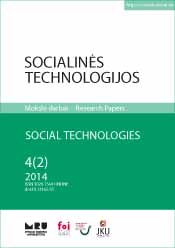ENHANCING SOCIETAL RESILIENCE AGAINST DISASTERS: ENGAGING THE PUBLIC VIA SOCIAL TECHNOLOGIES
ENHANCING SOCIETAL RESILIENCE AGAINST DISASTERS: ENGAGING THE PUBLIC VIA SOCIAL TECHNOLOGIES
Author(s): Birutė Pitrėnaitė-Žilėnienė, Paolo Vallesi, Andrea CarosiSubject(s): Social Sciences
Published by: Mykolas Romeris University
Keywords: societal resilience; ICT solutions for disaster management; disaster management related e-tools.
Summary/Abstract: Purpose – The research aims to discuss the importance of introduction of ICTs in the concept of societal resilience building and analyze e-tools engaging the public in safety enhancement. Methodology – The authors of this paper analyzed scientific literature to identify the main elements of societal resilience building, to distinguish the areas in which social technologies could be applied for the purposes of enhancing resilience. Empirical study was focused on the search and content analysis of global, EU, Lithuanian national and local e-tools created to inform the public about imminent and/or actual disasters and emergencies, communicate data among civil protection authorities, and collect from and disseminate among society disaster related information. Findings – Contemporary disaster management is increasingly orienting on preventive activities based on inclusion of society. Evolving the concept of societal resilience focuses on enhancing abilities of communities or society to resist, absorb, accommodate and recover from the effects of a hazard in a timely and efficient manner. Consequently, resilience moves from a passive technical concept, relevant to resistance of infrastructures, to a socially active process, supporting the phase of risk prevention. Therefore, it should be present in all phases, from risk prevention to emergency management. In the Internet enabled society, information and communication technologies (ICTs) could foster building of the capacity of resilience in urban and regional complex systems by informing, warning and directing people for correct actions in case of disasters. There is a number of e-tools designed for exchange of information at different levels (global, EU, national, local, organizational), serving for different tasks of pre-, during or/and post-disaster management. Those could be grouped by their purposes to the following ones: e-tools for warning of communities at risk, based on broadcasting; WebGIS-based crowdsourcing platforms to collect and update user generated content; Open-source ICT platforms Oriented on Public awareness on natural disasters; ICTs for civil protection planning, decision making for response, recovery and allocation of resources in case of disasters. The most oriented on public engagement are broadcasting and crowdsourcing based ICT tools. However, the empirical research revealed that use of such kind of social technologies by Lithuanians remains relatively vague in terms of public activity: crowdsourcing platforms are mostly uploaded with small-scale problems of everyday life character, and use of the broadcasting services among citizens is not popular enough yet, and some organizational and technological barriers worsen situation even more. This could point to an assumption that Lithuanian society does not percept disasters as real threats for their lives, health, property or environment.
Journal: Socialinės Technologijos
- Issue Year: 4/2014
- Issue No: 02
- Page Range: 318-332
- Page Count: 15
- Language: English

